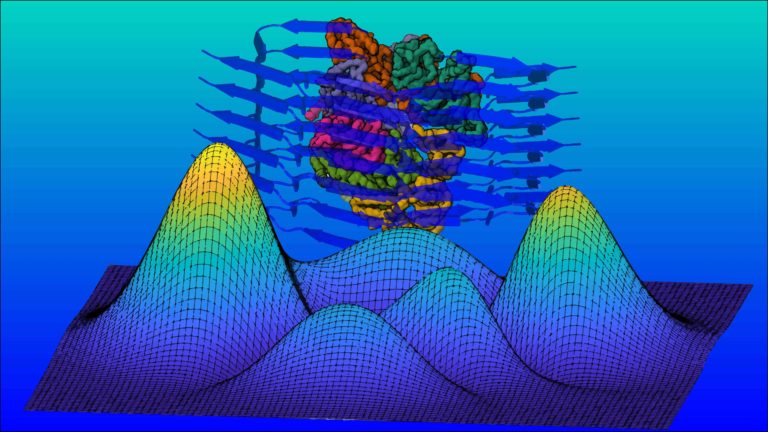Hsp104 chaperone inhibits formation of amyloids, precursors of Alzheimer’s disease
Work done in the lab of Dr. G. Marius Clore at Laboratory of Chemical Physics, National Institutes of Health, USA.
Shreya Ghosh received her B.Sc and M.Sc degrees in Chemistry at Visva-Bharati University, Santiniketan, India. To pursue her interest in research, she joined the University of Pittsburgh, USA in the lab of Dr. Sunil Saxena. Her doctoral work involved developing copper-based spin labels for proteins and DNA to be used for electron paramagnetic resonance (EPR) spectroscopy. Furthermore, using these labels and EPR-based distance measurements, she studied interactions between protein and DNA and associated conformational changes. She is currently pursuing her postdoctoral research in the lab of Dr. G. Marius Clore. Her work there involves probing chaperone mechanisms and kinetics involving aggregating client proteins using nuclear magnetic resonance (NMR) spectroscopy as the primary technique. Besides research, she enjoys dancing, hiking and cooking different cuisines.

Author Interview
How would you explain your research outcomes to the non-scientific community?
Protein folding is a pivotal event in cellular processes. Inappropriate folding can not only lead to loss of protein function, but also protein aggregation and fibrillization, thereby affecting cell physiology. Misfolding and subsequent formation of protein aggregates, or amyloidogenic aggregates, have been implicated in many diseases including neurodegenerative disorders.
Molecular chaperones and heat shock proteins assist in proper protein folding, dissolution and clearance of protein aggregates. The latter is a function of a class of chaperones called Disaggregase such as Hsp104.
The chaperone Hsp104 prevents fibril formation of a variety of amyloidogenic peptides but strangely in a substoichiometric manner. To understand the mechanism whereby Hsp104 inhibits fibril formation, we probed the interaction of Hsp104 with the Alzheimer’s amyloid-β42 (Aβ42) peptide using a variety of biophysical techniques.
We used 2D-NMR to monitor the disappearance of amyloid-β42 monomers during aggregation, and developed a kinetic model that quantitatively accounts for the experimental data over a wide range of Hsp104 concentrations. At high amyloid-β42 concentrations, aggregation occurs via a branched mechanism: (1) an on-pathway irreversible fibrillization process which leads to mature fibrils, and (2) an off-pathway reversible oligomerization process which leads to non-fibrillar oligomers that are too large to be observed directly by NMR but too small to be imaged.
Hsp104 binds reversibly to sparsely populated Aβ42 nuclei that are present in nanomolar concentrations with very high (nanomolar) affinity, thereby completely inhibiting the on-pathway process at substoichiometric ratios of Hsp104 to Aβ42 monomers.

“Hsp104: a Potential Therapeutic Disaggregase to Reverse Amyloid Aggregation in Neurodegenerative Diseases.”
How do these findings contribute to your research area?
Every year neurodegenerative diseases such as Alzheimer’s and Parkinson’s affect millions worldwide with, currently, no way to slow the disease progression and no known cures. Neurodegenerative diseases are primarily caused by misfolded proteins such as amyloid-β42, which form aggregates. To protect against the effects of protein misfolding all organisms employ chaperones.
Chaperones are primarily responsible for proper folding of newly synthesized polypeptide chains. But once misfolded, there is a special class of chaperones, called disaggregases, that come to the rescue. Hsp104 is one such disaggregase found in yeast but it is also well tolerated if introduced in mammals.
As fibril formation is usually an irreversible process, understanding the mechanism and kinetics of how Hsp104 is able to reverse the aggregation process and prevent fibril formation will allow a better understanding of the activity of disaggregase chaperones on aggregating clients and will further create avenues for development of therapeutic disaggregases with appropriate protein engineering methods.
What was the exciting moment during your research?
The process of fibril formation is usually spontaneous and irreversible, which is why most neurodegenerative diseases do not have cure yet. To be able to experimentally see that Hsp104 is indeed preventing fibril formation and to be able to quantitatively explain “how” it does so, has been very exciting.
What do you hope to do next?
The uniqueness of Hsp104 lies in the fact that it is the “only known chaperone to disaggregate fibrils”. But there exists a lot of disputes regarding this fact with some claiming Hsp104 is unable to do so while some claiming otherwise. Since disaggregation of fibrils is indeed a unique and highly important mechanism, I will be working on Hsp104 interacting with several type of fibrils to probe its disaggregation capability.
Where do you seek scientific inspiration from?
The love for science was instilled in me by my parents and then pushed further by several mentors, starting from school till now.
How do you intend to help Indian science improve?
I wish to advocate to young scientists who are starting their journey that even though scientific research does not provide instant gratification and requires a lot of patience, eventually everything works out. The sense of accomplishment after a successful scientific project is immense and overweighs any monetary achievements as it happens in other professions. I would like to hold scientific fairs and outreach events for high school and undergraduate students to get them more interested in science, just as I had done during my PhD.
Reference: Shreya Ghosh, Vitali Tugarinov, and G. Marius Clore . Quantitative NMR analysis of the mechanism and kinetics of chaperone Hsp104 action on amyloid-β42 aggregation and fibril formation. PNAS. 2023. 120 (21) e2305823120 https://www.pnas.org/doi/10.1073/pnas.2305823120
Edited by: Ritvi Shah
Biopatrika: Bringing Science to Society
© Biopatrika 2023 All Rights Reserved.